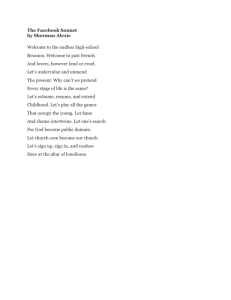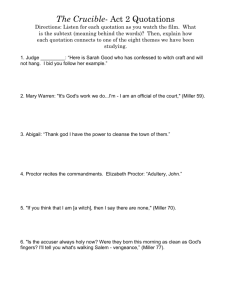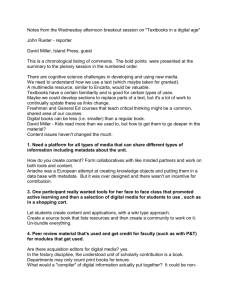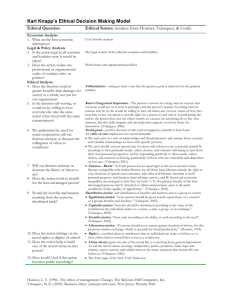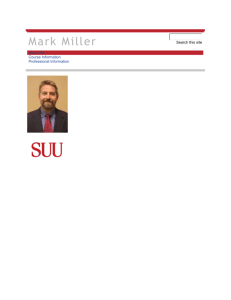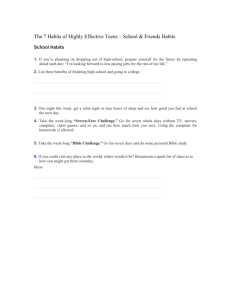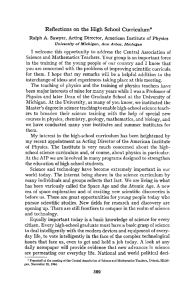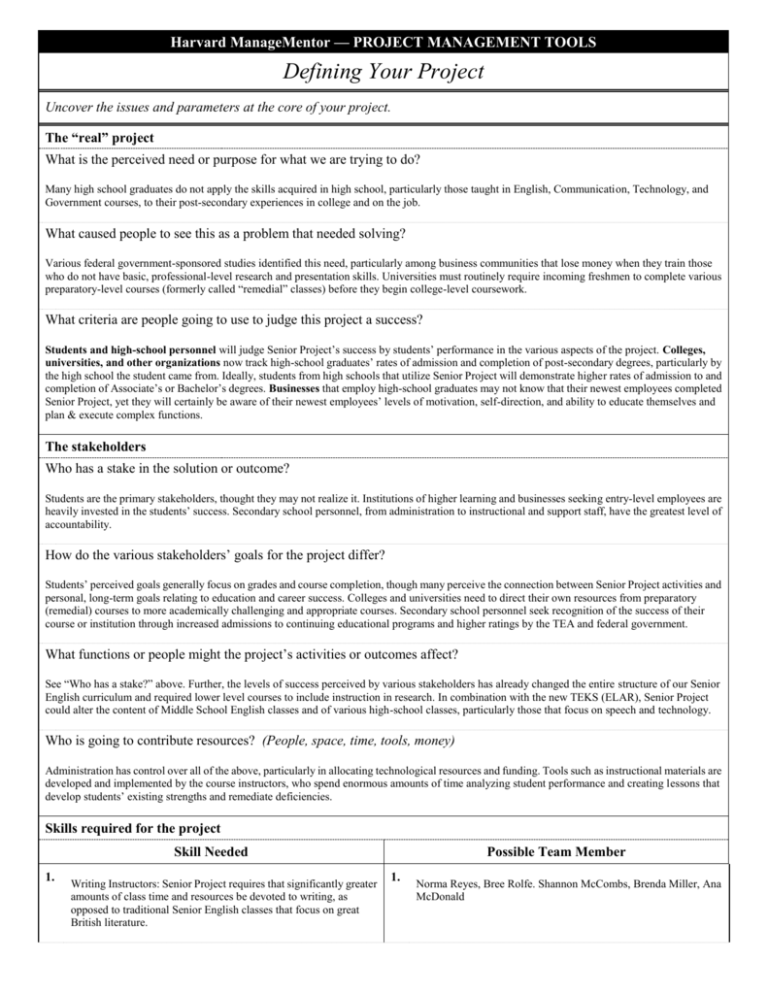
Harvard ManageMentor — PROJECT MANAGEMENT TOOLS
Defining Your Project
Uncover the issues and parameters at the core of your project.
The “real” project
What is the perceived need or purpose for what we are trying to do?
Many high school graduates do not apply the skills acquired in high school, particularly those taught in English, Communication, Technology, and
Government courses, to their post-secondary experiences in college and on the job.
What caused people to see this as a problem that needed solving?
Various federal government-sponsored studies identified this need, particularly among business communities that lose money when they train those
who do not have basic, professional-level research and presentation skills. Universities must routinely require incoming freshmen to complete various
preparatory-level courses (formerly called “remedial” classes) before they begin college-level coursework.
What criteria are people going to use to judge this project a success?
Students and high-school personnel will judge Senior Project’s success by students’ performance in the various aspects of the project. Colleges,
universities, and other organizations now track high-school graduates’ rates of admission and completion of post-secondary degrees, particularly by
the high school the student came from. Ideally, students from high schools that utilize Senior Project will demonstrate higher rates of admission to and
completion of Associate’s or Bachelor’s degrees. Businesses that employ high-school graduates may not know that their newest employees completed
Senior Project, yet they will certainly be aware of their newest employees’ levels of motivation, self-direction, and ability to educate themselves and
plan & execute complex functions.
The stakeholders
Who has a stake in the solution or outcome?
Students are the primary stakeholders, thought they may not realize it. Institutions of higher learning and businesses seeking entry-level employees are
heavily invested in the students’ success. Secondary school personnel, from administration to instructional and support staff, have the greatest level of
accountability.
How do the various stakeholders’ goals for the project differ?
Students’ perceived goals generally focus on grades and course completion, though many perceive the connection between Senior Project activities and
personal, long-term goals relating to education and career success. Colleges and universities need to direct their own resources from preparatory
(remedial) courses to more academically challenging and appropriate courses. Secondary school personnel seek recognition of the success of their
course or institution through increased admissions to continuing educational programs and higher ratings by the TEA and federal government.
What functions or people might the project’s activities or outcomes affect?
See “Who has a stake?” above. Further, the levels of success perceived by various stakeholders has already changed the entire structure of our Senior
English curriculum and required lower level courses to include instruction in research. In combination with the new TEKS (ELAR), Senior Project
could alter the content of Middle School English classes and of various high-school classes, particularly those that focus on speech and technology.
Who is going to contribute resources? (People, space, time, tools, money)
Administration has control over all of the above, particularly in allocating technological resources and funding. Tools such as instructional materials are
developed and implemented by the course instructors, who spend enormous amounts of time analyzing student performance and creating lessons that
develop students’ existing strengths and remediate deficiencies.
Skills required for the project
Skill Needed
1.
Writing Instructors: Senior Project requires that significantly greater
amounts of class time and resources be devoted to writing, as
opposed to traditional Senior English classes that focus on great
British literature.
Possible Team Member
1.
Norma Reyes, Bree Rolfe. Shannon McCombs, Brenda Miller, Ana
McDonald
2.
3.
4.
5.
6.
Enforcers: ability to motivate students to participate effectively and
complete required assignments in and out of class
Models: ability and inclination to create professional-level
instructional materials. We cannot expect our students to produce
professional-level portfolios if we do not apply the same standards
to our own products.
Mediators: ability to acquire funding and resources from
administration and to present team members’ concerns and solutions
positively
Liaisons: ability to interact with the community to bring in
appropriate mentors, team members, and judges. One difficulty in
our district involves the requirement that volunteers pass
background checks. Another difficulty is that our district is located
in a rural area with a high level of poverty. Many of the professionals
available to serve the above roles must travel outside of their city
and comfort zone.
Innovators: ability to devise solutions to problems encountered by
students, particularly in modifying plans to meet changing
circumstances and lack of resources (money is particularly difficult
with our population, as is the difficulty in recruiting mentors who
have the flexibility to work with students who have limited access to
transportation and/or who must work 30- and 40-hour weeks to
provide for their families basic needs).
2.
3.
4.
5.
Steven Alves, Shawn Trestan, Sharon Churchin, Pilar Westbrook,
David Williams, Beth Fox
Cynthia Miller, Ana McDonald, Brenda Miller, Shannon McCombs
Pilar Westbrook, Shannon McCombs, Liz Velasquez
Dee Peters, Elizabeth Velasquez, Sylvia & Bobby Fowler, selected
parents, Cathy Collins, Beth Fox
We intend to involve the entire campus in recruiting appropriate
persons to serve as (off-campus) mentors.
(Liaisons within the high-school community: Cynthia Miller, Dee
Peters, Liz Velasquez, Cathy Collins, Pilar Westbrook)
6.
Dee Peters, Liz Velasquez, Brenda Miller, Ana McDonald
© 1999 by the President and Fellows of Harvard College and its licensors. All rights reserved.

